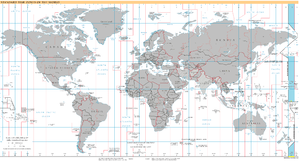UTC−12:00: Difference between revisions
m Undid revision 1039002205 by 139.0.46.23 (talk) |
→Characteristics of UTC−12:00: reword "if a deadline has not passed in the UTC–12:00 zone, the deadline has not yet passed 'Anywhere on Earth'"—this wording is incorrect because the deadline may certainly have passed in many places on Earth |
||
| Line 14: | Line 14: | ||
A number of inhabited territories lie within the longitudinal limits of this time zone ([[Tonga]], [[Wallis and Futuna]] and [[Chatham Islands]] as well as parts of [[Chukotka Autonomous Okrug]] of [[Russia]], the US state of [[Alaska]], [[Fiji]], [[Tokelau]] and [[Samoa]]) but none of them keeps the date and time of UTC−12:00. Instead, they keep the time and date (or just the date) of one of the neighboring zones, usually because they belong, politically, to a country which lies mostly in the neighboring time zone. |
A number of inhabited territories lie within the longitudinal limits of this time zone ([[Tonga]], [[Wallis and Futuna]] and [[Chatham Islands]] as well as parts of [[Chukotka Autonomous Okrug]] of [[Russia]], the US state of [[Alaska]], [[Fiji]], [[Tokelau]] and [[Samoa]]) but none of them keeps the date and time of UTC−12:00. Instead, they keep the time and date (or just the date) of one of the neighboring zones, usually because they belong, politically, to a country which lies mostly in the neighboring time zone. |
||
Since the '''International Date Line West (IDLW)''' time zone represents the last place on [[Earth]] where a particular time and/or date exists, it is referred to as [[Anywhere on Earth]] (AoE). |
Since the '''International Date Line West (IDLW)''' time zone represents the last place on [[Earth]] where a particular time and/or date exists, it is referred to as [[Anywhere on Earth]] (AoE). A deadline specified as "Anywhere on Earth" has not passed if, anywhere on Earth, the deadline has not passed, or, equivalently, if the deadline has not passed in the UTC–12:00 zone.<ref name="IEEE"/> |
||
The IDLW is also used in [[software testing]] for time zone related code that uses system default time zone, as in some cases they may be the same as on the developer's computer.{{cn|date=February 2020}} Since the area of the IDLW has no programmers or data centers, there is no conflict. |
The IDLW is also used in [[software testing]] for time zone related code that uses system default time zone, as in some cases they may be the same as on the developer's computer.{{cn|date=February 2020}} Since the area of the IDLW has no programmers or data centers, there is no conflict. |
||
Revision as of 13:09, 22 August 2021
This article needs additional citations for verification. (January 2008) |
| UTC−12:00 | |
|---|---|
| Time zone | |
 World map with the time zone highlighted | |
| UTC offset | |
| UTC | UTC−12:00 |
| Current time | |
| 23:32, 13 September 2024 UTC−12:00 [refresh] | |
| Central meridian | |
| 180 degrees | |
| Date-time group | |
| Y | |

UTC−12:00 is an identifier for a time offset from UTC of −12:00. It is the last to enter a new year, and is sometimes referred to as the International Date Line West time zone (IDLW).[1]
As standard time (all year round)
Oceania
 Vereinigte Staaten
Vereinigte Staaten
- Baker Island and Howland Island (uninhabited islands belonging to the United States)
UTC−12:00 is a nautical time zone comprising the high seas between 180° and 172°30′W longitude, and the time is obtained by subtracting twelve hours from UTC.
Characteristics of UTC−12:00
A number of inhabited territories lie within the longitudinal limits of this time zone (Tonga, Wallis and Futuna and Chatham Islands as well as parts of Chukotka Autonomous Okrug of Russia, the US state of Alaska, Fiji, Tokelau and Samoa) but none of them keeps the date and time of UTC−12:00. Instead, they keep the time and date (or just the date) of one of the neighboring zones, usually because they belong, politically, to a country which lies mostly in the neighboring time zone.
Since the International Date Line West (IDLW) time zone represents the last place on Earth where a particular time and/or date exists, it is referred to as Anywhere on Earth (AoE). A deadline specified as "Anywhere on Earth" has not passed if, anywhere on Earth, the deadline has not passed, or, equivalently, if the deadline has not passed in the UTC–12:00 zone.[1]
The IDLW is also used in software testing for time zone related code that uses system default time zone, as in some cases they may be the same as on the developer's computer.[citation needed] Since the area of the IDLW has no programmers or data centers, there is no conflict.
See also
References
- ^ a b "IEEE 802.16 AOE Deadline Documentation". IEEE 802 LAN/MAN Standards Committee. Retrieved 1 January 2018.
